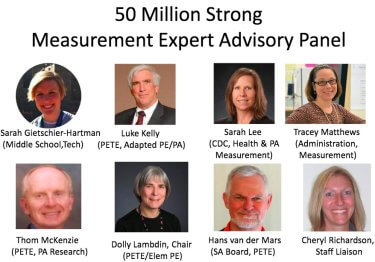What was described in my previous post was step one of the assessment plan presented at the 50 Million Strong Forum at the SHAPE America Convention in Boston 2017. Step one involved the use of nationally available high school and middle school level data to track our 50 Million Strong progress and guide our actions. In addition to the discussed behaviors addressed in YRBS and policies addressed by SHHPS and SHAPE of the Nation, teachers must be able to assess the national health and physical education content standards. Students must learn the skills, knowledge, competence and desire to be physically active and make healthy choices and so we need to track program success in the national standards. To this end there is a need for additional assessments teachers can use that showcase student mastery of key knowledge, and skills. These are being developed by additional task forces. A brief overview is given below.
| Assessment | Rationale for use | Examples |
| NATIONAL SURVEILLANCE MEASURES
National surveillance measures of health behaviors (mostly self report), state and national policy (selected items from YRBS, SHAPE of the Nation, SHHPS)
50 Million Strong by 2029: Tracking Progress Toward Achieving Our Goal(Publisher’s Note: This article is based on a presentation made by the author as part of the 50 Million Strong by 2029 Forum held at the 2017 SHAPE America National Convention.) In 2016, SHAPE America made a commitment to ensure that by 2029 all of America’s youth will be “empowered to live healthy and active lives through effective health and physical education programs” (SHAPE America 2016). Since then, many people have asked how will we ensure that we are making progress toward this goal, or how and when will we know if we have achieved it? To this end, SHAPE America President Steve Jefferies appointed a Measurement Advisory Panel tasked with wrestling with these issues and identifying how we should begin to measure progress. The Advisory Panel included the following professionals:
|
